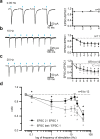D5 dopamine receptors control glutamatergic AMPA transmission between the motor cortex and subthalamic nucleus
- PMID: 29891970
- PMCID: PMC5995923
- DOI: 10.1038/s41598-018-27195-6
D5 dopamine receptors control glutamatergic AMPA transmission between the motor cortex and subthalamic nucleus
Abstract
Corticofugal fibers target the subthalamic nucleus (STN), a component nucleus of the basal ganglia, in addition to the striatum, their main input. The cortico-subthalamic, or hyperdirect, pathway, is thought to supplement the cortico-striatal pathways in order to interrupt/change planned actions. To explore the previously unknown properties of the neurons that project to the STN, retrograde and anterograde tools were used to specifically identify them in the motor cortex and selectively stimulate their synapses in the STN. The cortico-subthalamic neurons exhibited very little sag and fired an initial doublet followed by non-adapting action potentials. In the STN, AMPA/kainate synaptic currents had a voltage-dependent conductance, indicative of GluA2-lacking receptors and were partly inhibited by Naspm. AMPA transmission displayed short-term depression, with the exception of a limited bandpass in the 5 to 15 Hz range. AMPA synaptic currents were negatively controlled by dopamine D5 receptors. The reduction in synaptic strength was due to postsynaptic D5 receptors, mediated by a PKA-dependent pathway, but did not involve a modified rectification index. Our data indicated that dopamine, through post-synaptic D5 receptors, limited the cortical drive onto STN neurons in the normal brain.
Conflict of interest statement
The authors declare no competing interests.
Figures




References
Publication types
MeSH terms
Substances
LinkOut - more resources
Full Text Sources
Other Literature Sources

